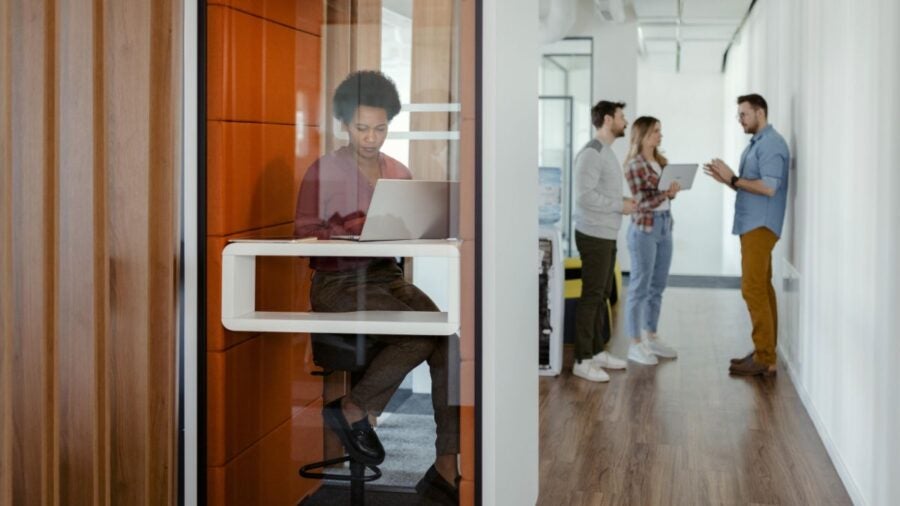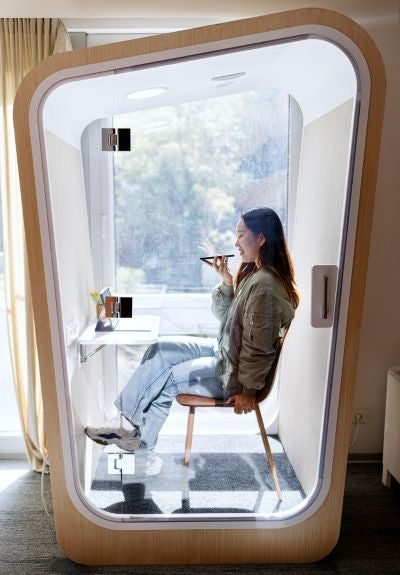
Before the pandemic, open-plan office space was the preference for most businesses. Now, after employees have become used to the quiet and privacy of their homes, companies pushing for a return to HQ need to accommodate this. As a result, a new piece of office furniture has started breaking up the uninterrupted rows of desks.
Large, glass-fronted boxes, big enough to squeeze in one person and a laptop are now a common presence. These soundproof booths have quickly become a staple as workers request space to shut themselves away from the distractions of the office to take calls or concentrate.
Office rental agency Sketch Labs has witnessed this surge in demand first-hand. Pre-pandemic, no one was requesting this office amenity. In the first month of this year, however, 23 of the 24 companies it consulted had a requirement for private booths.
Companies are under great pressure to offer their employees the best office spaces
Agency founder and CEO Mark Knops believes the demand is being driven by a combination of new norms and shiny novelty. “It may be that people have become used to doing their phone calls privately while working from home, or perhaps cubicles are just the ‘new toy’ that people want in their office,” he says. “Whatever the reason, they’re a great addition to offices and used heavily.”
The price of privacy
But, while these soundproof cubicles are proving popular with office workers, they come with a hefty price tag. Danish workspace designer MuteBox’s telephone cubicles can be found in the head offices of EY, Volvo and Nespresso, and prices range from just under £5,000 to £14,000.
A perceived demand from staff has meant businesses have been undeterred by the price tag. Knops adds: “Companies are under great pressure to offer their employees the best office spaces that are well located and have good amenities. All of this means better employee retention and attraction.”

However, he remains reluctant to buy into the trend. “For my money, they’re not worth the price,” he says. “The cost is eye-watering. However, if they are welcomed in office spaces, and the landlord has the budget to do so, the cost can make sense.”
Simon Rowley, director of flex workspaces at London property developer GPE believes that the “massive demand” for private booths is being driven by the need for employers to “earn the commute” and create work environments that employees are happy to travel to.
“The main downfalls of serviced offices were a lack of privacy, a lack of security and an inability to create a culture for your business,” he explains. “Coming out of the pandemic, the need for those three things was accentuated.”
Office spaces therefore have to be more multi-purpose and these small, contained soundproof booths allow for some people to do private work alongside more collaborative, noisier work.
Every flexible office space that GPE provides now comes fitted with at least one phone booth and many clients are asking for more to be fitted, says Rowley. “People just don’t want to be on a call with everyone else shouting around them,” he adds.
Another benefit is that these booths are mobile. If a client’s requirements change, they can easily be removed and, with demand so high, a new home can usually be found for it quickly. “It gives us more flexibility and it’s better for sustainability as we don’t have to scrap loads of plasterboard when taking out meeting rooms,” Rowley adds.
It also speaks to a better understanding of people’s workplace requirements. “Awareness of neurodiversity also has a part to play in this trend,” Rowley explains. “There is far more awareness that people have different needs and they work in different ways. And office fitouts have changed to accommodate that.”
Are we heading back to the 90s?
The proliferation of office cubicles may lead some to believe that we’re heading back to a time when office design was more utilitarian – the 1990s. But fully embracing booths and getting rid of more open-plan office space, says Knops, would be a mistake. “It’s not good for people’s mental health and defeats the purpose of encouraging your employees back to the office. They may as well work from home.”
My ideal work environment is one where you leave feeling better than when you arrived
Despina Katsikakis, president of the British Council for Offices, claims that the resurgence of office cubicles speaks to a lack of creativity in workplace design. “We’re thinking about office space like we’re still in the 1970s and the computer hasn’t been invented,” she says. “People are resorting to putting in cubicles, as opposed to rethinking how we work and what the right spaces are to support this.”
In her opinion, office space needs to be intentionally designed to support the work that takes place there. This could involve zoning off areas for different types of work or creating library areas where people can complete tasks in silence.
“We need places to work without interruption, but a cubicle doesn’t achieve this, it only adds an artificial boundary,” Katsikakis adds. “Businesses need to be thinking about spaces that support their people’s ability to work.”
Returning to old ways of working accomplishes neither of these things. Instead companies need to design office space with functionality and individual preferences in mind – a one-size-fits all solution rarely works. “The ideal work environment is one where you leave feeling better than when you arrived,” says Katsikakis. “I don’t believe the cubicle is the answer.”

Before the pandemic, open-plan office space was the preference for most businesses. Now, after employees have become used to the quiet and privacy of their homes, companies pushing for a return to HQ need to accommodate this. As a result, a new piece of office furniture has started breaking up the uninterrupted rows of desks.
Large, glass-fronted boxes, big enough to squeeze in one person and a laptop are now a common presence. These soundproof booths have quickly become a staple as workers request space to shut themselves away from the distractions of the office to take calls or concentrate.
Office rental agency Sketch Labs has witnessed this surge in demand first-hand. Pre-pandemic, no one was requesting this office amenity. In the first month of this year, however, 23 of the 24 companies it consulted had a requirement for private booths.
